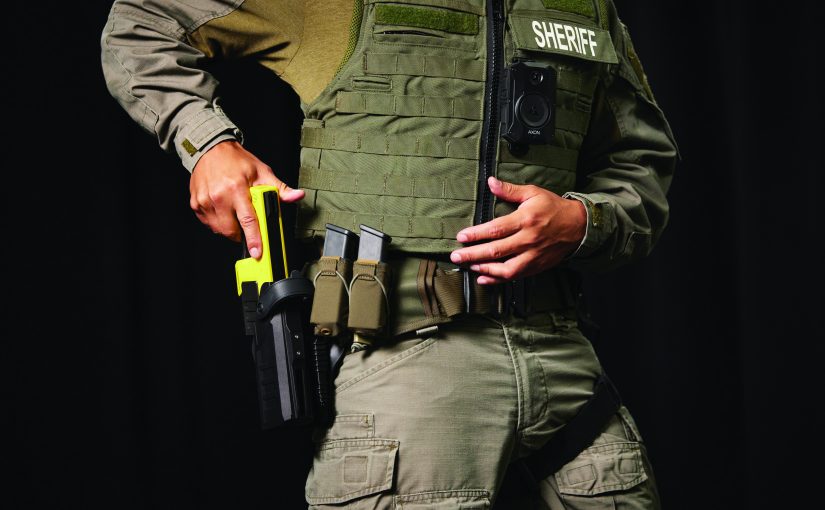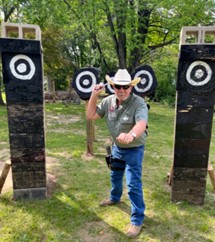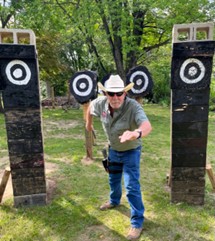Most officers today have some working knowledge and training in how various human and environmental factors impact officer safety, critical decision-making and force option selection. Specifically, officers taking use-of-force/deadly force classes are taught how to deal with dangerous subjects they encounter who are armed with edged weapons. In 1983, Salt Lake City Police Department Sergeant Dennis Tueller developed a training lesson to teach officers about the concept of “action – reaction perception lag time” and the “reactionary gap.” This important lesson, which teaches the formula of distance verses reaction time (D vs. RT), now known as the “Tueller Drill,” is still taught in many use-of-force and firearms classes today.
Tueller’s principle demonstrated that a subject armed with a knife 21 feet away from an officer with their sidearm holstered, could easily engage and kill the officer before the officer could react, draw, aim, and fire their weapon.1 Action is always faster than reaction.
A 20th century U.S. Air Force fighter pilot, Major John Boyd, developed a combatives concept based on psychophysiology that he referred to as the “OODA Loop,” to teach fighter pilots how to better engage and defend against and destroy opposing pilots. OODA is an acronym for Observe, Orient, Decide, and Act.2
There is a large body of vetted, published research in the fields of psychology, physiology, biomechanics, vision, hearing, and physics that contributes to what is known about how the body reacts to threats against life. This research shows that, when the average human experiences a threat to their life, the five basic responses are (1) defend (fight); (2) disengage from the threat (flee); (3) warn the threatening actor (posture); (4) become confused, panic, and/or freeze; and (5) submit/surrender.
“Remember that when chasing after someone, the officer is significantly reducing their reactionary gap as well as their ability to visually assess the threat”
When humans experience what they perceive to be a life threat, the brain automatically engages the OODA Loop. However, the brain first prepares the body for the threat by immediately and involuntarily dumping “survival chemicals” into the body. These survival chemicals are adrenaline (a powerful stimulant) and endorphins, which are pain blockers, including dopamine. These powerful chemicals can both help and hinder the body’s performance and its ability to survive an attack.
For instance, the stimulant adrenaline drastically increases the body’s basal metabolic rate, which is measured by respiration, heart rate, and blood/fluids pressure. On the positive side, once adrenalized, the body can act faster and more powerfully. The body can run faster and fight harder, and its strength potential can rise exponentially. However, on the negative side, pressurized vitreous fluid in the eyes can change the shape of the cornea. This can cause depth perception problems and drastically reduces peripheral vision from 180° all the way down to 10° off of center. This sudden and extreme narrowing of the field of vision is referred to as “tunnel vision” or “an island within a sea of blindness.”
When the human body responds to a life threat, the overproduction of adrenaline reduces blood flow to the ears, causing diminished or total temporary hearing loss. At the same time, the brain ignores less critical input to focus on visual stimuli. Obviously, not only can both circumstances significantly reduce the body’s ability to survive a deadly encounter, but they can negatively affect critical decision-making and deadly force decisions and cause lapses in stress recall memory.
As discussed in a 2014 article by Dr. Ron Martinelli, “Revisiting the 21-Foot Rule,” once the body experiences a life threat and the brain engages the OODA Loop, it takes time to move through the observe, orient, decide, and act components.3 Depending upon which research articles one reads, generally it takes between.55 and.58 seconds for the average trained officer or civilian to observe and orient (process) a threat to their life. Then it generally takes another.55 to.56 seconds for the brain to select which of the five basic options available the brain thinks that the body can perform to address the threat. Finally, the brain must tell the body to act and engage the plan. This also takes time, and that’s the purpose of this research and article.
The Combative Art of Knife Throwing
In 2023, I (Ron Martinelli) was doing background research on the combative art of knife throwing when I came upon internet videos of knife throwing expert Matthew Dunn. I reached out to Matt to teach me how to throw knives. He graciously agreed. After traveling to Matt’s unique combat range in New Jersey, I received three days of intensive training, learning the challenging martial art of combat knife throwing. By the end of my second day, I had learned how to accurately throw a specially designed 10-inch Arvo fixed blade knife both underhand and overhand at single and multiple 14-inch targets. By the end of my training, I had learned how to accurately center-punch a fast-moving attacking target coming straight at me.
Watching Matthew Dunn, a trained expert, access and accurately throw deadly knives in the blink of an eye while monitoring my own progress, speed, and accuracy after only two days gave me pause. Officers up against experienced subjects who can throw knives are at a serious disadvantage, even when unholstered and positioning their weapon in the low-ready position toward their adversaries. The OODA Loop works against officers at close distances. In an effort to confirm my theory, Matt and I put applied sciences and human factors to test this hypothetical: “Which is faster, the gun or a knife in the hands of an experienced knife thrower?”
“Any use of force, especially deadly force, involves an officer’s objective probable cause belief that the assailant poses an imminent threat of serious bodily injury”
First, we arranged single and multiple 14-inch stationary targets at distances of both 8 feet and 12.5 feet and used a speed gun to clock the velocity of our throws. Next we tested for accuracy. We allowed only for solid, center-mass hits on a 14-inch target. This would mean a knife striking only the eight, nine, or ten rings, which reduced the target size down to roughly 10 inches. Hits within this area would be considered as “center-mass” hits. We conducted three hours of our experiments documented by video and photographs. The results were both astonishing and disturbing. Our combined efforts showed that unholstered with our hands behind us for underhand throws, or at the “ready” position for overhand throws, we could consistently strike targets center-mass at speeds of between 30 to 34 mph.
Furthermore, the published human factors research on experimental, timed “gunfight” and edged weapon, Tueller Drill-type scenarios, has generally documented that a trained officer takes about 1.0 to 1.5 seconds to raise up from the “low-ready” to the “on-target” positions. It then takes that trained officer around.33 seconds to depress the trigger of a firearm.
In the brief experiments, we found that we could access and deliver a 10-inch lethal missile traveling 30 mph from 13 feet away with point of delivery center-mass hit on target in only 0.29 seconds! At 30 mph, that knife is traveling at roughly 45 feet/second.
The following week, after Matthew Dunn had studied videos of Major League Baseball pitchers throwing a fastball, he was able to mimic the biomechanics, which then allowed him to greatly increase his knife throwing speeds to between 100 and 102 mph. At 100 mph, the knife is traveling to its target at 146.6 feet/ second. If an officer was 13 feet away from the knife throwing assailant, the officer’s reaction time to depress the trigger of their handgun would have to be an impossible 0.088 seconds!
Continuing these knife throwing experiments, we found that a skilled knife thrower hurling a knife from a “reasonably safe” distance of 20 feet, at a speed of 50 mph or 73.3 feet/second can accurately strike the officer in 0.27 seconds. If the officer was 20 feet away from the assailant and the knife was thrown at a speed of 100 mph, the officer would have only 0.13 seconds to complete the OODA Loop and depress the trigger of their handgun.4
| Knife Speed | Distance Calculations |
| MPH | Feet/Second |
| 30 | 44 Ft/Sec. |
| 35 | 51 Ft/Sec. |
| 50 | 73 Ft/Sec. |
| 100 | 146.5 Ft/Sec. |
The obvious danger to officers is that even a trained officer with their gun pointed toward a knife-wielding adversary with their finger on the trigger would not be able to complete the OODA Loop before the subject armed with the knife could accurately throw their knife and strike the officer.
In situations where an officer is holstered, as in a foot pursuit, and then suddenly encounters a fleeing subject who instantly turns around with a throwing knife in their hand, the officer is faced with making an immediate “shoot – don’t shoot” force decision. This can lead to further delay in thought processing such as Hick’s Law.
“Always consider that a person armed with a knife can not only engage and stab their target but can easily throw and accurately kill someone with that knife at distances under 20 feet”
Hick’s Law is a psychological premise that teaches that the more options available to a person, the longer the decision-making and action time it takes to respond. In the case of an officer, their thought process (decision to act) may be further impaired by considering department policy, disciplinary actions, criminal prosecution, and/or civil litigation if they make the wrong decision. Once other distractions or impairments such as lighting, the physical environment, time, distance, and the presence of onlookers are added to the scenario, it is easy to see how quickly the officers find themselves at a clear disadvantage against knife throwers.
Recommendations
Even though these knife throwing human factors experiments are relatively new, this work has raised some important tactical, officer safety, use of force, and legal issues that are important for officers, trainers, police practices experts, and agency defense attorneys consider.
1. Always keep in mind the Graham Standard when evaluating use of less-lethal or lethal force against a person with an edged weapon. Any use of force, especially deadly force, involves an officer’s objective probable cause belief that the assailant poses an imminent threat of serious bodily injury or death to the officer(s) and/or others.
2. Remember that distance is the officer’s friend. Longer distances equate to longer OODA Loop reaction times. The further the distance one is from a person with an edged weapon, especially a throwing knife, the harder it will be for the knife-wielding subject to accurately hit the officer or other target. Experienced knife throwers can easily and accurately hit their targets out to 20 feet. When dealing with a subject armed with a knife, the minimum distance the officer should be from them is 40 feet if the environment allows.
3. Use “scoot and shoot” tactics. When confronted by a knife thrower, once an officer detects an aggressive movement where they might have to respond with deadly force, officers should always remember to move off the “X” as they shoot.
4. If practical and available, seek and negotiate behind solid cover—something that will stop a heavy bladed knife.
5. Be very careful about bringing an electronic control weapon or any other less-lethal weapon to a knife fight. Always consider that a person armed with a knife can not only engage and stab their target but can easily throw and accurately kill someone with that knife at distances under 20 feet. These are the distances where ECWs, OC spray, and less-lethal munitions are most commonly deployed. Rather, think about using a two-officer team with a 40 mm less-lethal, multi-round impact munition, backed up by lethal force.
6. Generally, absent a trauma plate, body armor was never meant to repel sharp, heavy bladed, pointed throwing knives. Also, skilled knife throwers can easily strike targets where there is no body armor, such as a person’s head, stomach, groin, and legs.
7. Just because the subject with the knife is not holding the blade in an overhand attack posture does not mean that they can’t easily and accurately throw that knife underhand or from a “side/slashing” angle. Pay close attention to whether the subject is holding their knife in a master grip (on top of or to the side of the back spine of the knife). The way the subject holds the knife can provide a clue as to whether or not they are experienced in throwing knives. (See Images 1 and 2 for examples of overhand and underhand throwing grips.)
8. Foot pursuits are strongly discouraged unless absolutely necessary. Remember that when chasing after someone, the officer is significantly reducing their reactionary gap as well as their ability to visually assess the threat and successfully engage the OODA Loop.
The authors emphasize that their research into knife throwing, human factors, and deadly force has just begun. They encourage constructive comments and are making a video catalog of their research available upon request. d
Notes:
1Cameron Hashemi-Pour and Sarah Lewis, “OODA Loop,” TechTarget, The TechTarget Network, updated January 2024.
2Ron Martinelli, “Revisiting the ‘21-Foot Rule,’” Police, September 18, 2014.
3All About Circuits, Speed Distance Time Calculator.
Please cite as
Dr. Ron Martinelli & Matthew Dunn, “The Deadly Threat of Knife Throwing: Impacts on the OODA Loop and Force Options,” Police Chief Online, February 12, 2025.





